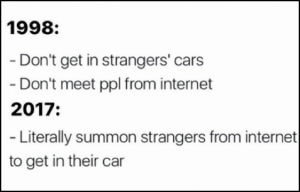
Articles
3 Reasons Why Post-Secondary Online Learning is Absolutely Crushing it
By Tim Coffey
August 03, 2017
3 reasons why post-secondary online learning is absolutely crushing it
A few weeks ago I ran across a Twitter post that read,
“1998: Don’t get in strangers’ cars. Don’t meet people from Internet. 
2017: Literally summon strangers from the Internet and get into their car.”
So true, isn’t it? It’s astounding how technology can cause major shifts in behavior. What we will and won’t do, and certainly how we transact, interact, and learn.
If you’re old enough to have been conscious in the mid 1980s, you might remember a commercial where Sally Struthers peddled degrees in gun repair or child day care. To think that one could earn some sort of degree without committing to time in a classroom was a questionable if not laughable proposition.
 Here we are, 25 years later. Distance learning has not only surmounted the Struthers stigma, but we’re seeing a shift in the offerings at institutes of higher education. ELearning is the norm and learners of all ages expect learning to be at least blended if not entirely online.
Here we are, 25 years later. Distance learning has not only surmounted the Struthers stigma, but we’re seeing a shift in the offerings at institutes of higher education. ELearning is the norm and learners of all ages expect learning to be at least blended if not entirely online.
Enrollment numbers at the university where I attended graduate school indicate a dramatic shift from classroom attendees to distance learners. So much, in fact, that the university recently made their biggest ever cut to staff and faculty positions. The reason was a downturn in student enrollment. The only area in the university still growing? Online learning. The same story is happening everywhere. So why has eLearning suddenly established so much traction at colleges and universities? Here’s some insight.
Reason #1 – ELearning is efficient like a solar-powered car
ELearning works in higher education for a lot of the same reasons it works in corporations. It allows us to achieve more with fewer resources. Well-executed synchronous or asynchronous deployment can be absorbed by learners at their pace without necessarily needing costly classroom space.
Ask any corporate eLearning developer how they rapidly develop learning assets and you should hear something about “reusable learning objects.” This is a fancy name for the practice of cataloging chunks of content so that they may be used in future lessons. Spending costly development hours to build something that’s already built is wasteful. So as chunks of content are built, they should be tagged, organized, and cataloged for future use.
Reason #2 – There are fewer college students
Despite the economic strain a college education puts on families when our economy suffers a downturn, college-aged students tend to ride out the storm by burrowing deep in the nest of higher education. Caroline Hoxby, Stanford economist explains the phenomenon in, How the Financial Crisis and Great Recession Affected Higher Education. She explains that in spite of the fact that it’s even more of a stretch to pay for college during tough economic times, enrollment has gone up during every recession since the 1960s.
During times of economic strength, however, students are lured away from the books to pursue opportunities in the workforce that are too good to pass up.
Reason #3 – ELearning fits with digital native expectations
 If Millennials came out of the womb clutching a mouse and navigating a touchpad, it could be said that members of Generation Z were born texting, posting, sharing, and vlogging. And as unappealing as traditional classroom learning is to Millennials, members of Generation Z are far more likely to opt for non-classroom learning options.
If Millennials came out of the womb clutching a mouse and navigating a touchpad, it could be said that members of Generation Z were born texting, posting, sharing, and vlogging. And as unappealing as traditional classroom learning is to Millennials, members of Generation Z are far more likely to opt for non-classroom learning options.
Be sure to read Cait Etherington’s article recounting Purdue University’s acquisition of Kaplan Inc.
In general, instructional designers in higher education have yet to fully incorporate some of the hottest modalities in the eLearning space. It’s only a matter of time before a college-level course includes things like complex branching scenarios, mobile learning, augmented reality (think Pokemon Go) and gamification. We should expect learning to become more organic and more akin to the types of learning students seek out on their own time.









No Comments